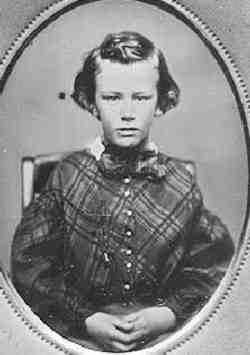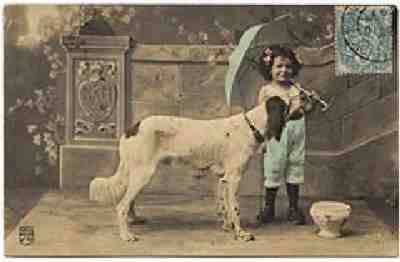
Figure 1.--e.


Figure 1.--e. |
Wigs generally disappeared by the advent of the 19th century, except for some professions such as judges and barristers. Men's hair styles varried sustantially during the decade. Boys generally were less effeted by stylistic changes, generally wearing short hair. There were some exceptions, however, as some adoring mothers chose to keep their sons in longer hair. This of course reached notable lengths during the Fauntleroy craze of the late 19th century. Such decissions were generally accepted as the mother's perogative, and the son's opinions on the matter were often dismissed. Much more information on boys' hairstyles becomes available in the 19th century, especially after the development of photography in the 1840s anf its increasing commercial success by the 1860s.
Hair styles varied greatly at the turn of the 19th century. The French under the Revolution (1789) had adopted short hair. Older and conservative men in other countries still wore formal powdered wigs, often in tight queues. More liberally oriented younger men
to destinguish themselves began wearing their own natural hair cut short in the French style. Wigs had declined in popularity in the 1790s, but many still powdered their natural hair and wore it in queues. Gradually European and American men increasingly began wearing their hair short. The military establishments of the world, including those fighting the French changed o short hair. The British parade their regiments out and had each other cot off his comrade's pigtail. Some time in the space of a few minutes the pigtails that had been worn for a century disappeared.
The transition from the 18th to 19th centuries was a time of enormous change in hair styles. This is recorded in the personal experiences of notable individuals. Tom Jeffereson (1743-1826), for example, as a boy did not wear wigs. As a student at William and Mary College, he did not cover his thick red hair with a wig. With he was elected to the Virginia House of Burgess, however, he felt compeled to wear wigs. He was a client of wigmaker Edward Charltom purchasing a varierty of brown wigs, including one with a queue. He finally settled on a bob wig, the most stlish at the time. When he served as Ambassador to France in the 1780s, he wore a formal powdered wig. Later he returned to his natural hair, at first powdered and with a queue. Finally as president he sttled on a natural style, fairly short but bushy.
Several styles emerged in the first half of the 19th century. Some of the most notable were:
Beau Brummel: The famous example of British fashion reportedly hired three hair stylists to maintain his hair. The three specialized in his front locks, side locks, and the back of his head.
Lord Byron: The idol of the young liberals was the Romantic English poet, Lord Byron. His libertine life style and evocative poetry inspired young liberals throughout Europe and America. The liberals influenced by Byron took to wearing long flowing "Byronic locks". They also began slickening their hair with the Macassar Oil mentioned in Byron's Don Juan.
In virtues nothing earthly could surpass her,
Save thine "incomparable oil," Macassar!
Oiled hair became so common that women began the Victorian fashion of putting doilies on the back s of chairs and sofas to protect them.

Figure 2.--This Dagerotype probably taken in the 1850s shows a boy in a plaid shirt. Notice the small white collar and bow. Also notice the longish hair and double part. |
The young men who began the 19th century by cutting their hair gradually became the older generation. Younger men gradually though to develop their own modern look and began wearing their hair longer. By the mid-19th century it was mostly the older generation who still wore their hair short, combed forward in the Roman style. The style was in their youth a symbol of their progressive thinking, in their older years it helped, not very effectively, to coceal baldness. The best example of his is James Bucanan, the American president (1857-61) in the years leading up to the Civil War. The youth movement of the mid-19th century involved hair that was bobbed. Some wire ringlets produced with curling irons, but the dominate style became straight, smooth hair, parted at the side.
A varierty of men's styles were notable at mid-century. One was the popular "cow lick," a single curl over the forehead. Another popular style was to roll the hair at the front of the head in what was referred tonas the Piccadilly Fringe.
There was considerable divdersity at mid-century. The individual had wide lattitude on how to wear his hair. Many did wear long hair, including Buffalo Bill, Wild Bill Hickcock, and General Custer yo name a few. One fashion book opined, "that there was "nothing unmany in wearing long hair, although undoubtedly it is ... a temptation to vanity." [The Habits of a Good Society, London, 1859]
The trend in the later 19th century was for shorter haor. While center parts remained popular, the dominate style beca,e incrwasingly short by the 1870s. An American etiquitte mannual proclaimed that the only men with long hair were "painters and fiddlers". [Good Society, 1869]
Women at the turn of the 19th century, influenced by the French Revolutionm wore short cut hair. They soon changed their minds and began wearing longer styles. Women in the first part of the 19th century, began arranging their hair in a series of ringlets which they permitted to fall to the side of their head and gathered around the back of the head with a ribbon. There were quite a diversity of styles. Some wore a kind of lop-sided half and half style where one side was combed straight and the other side had masses of curls. Braiding became popular and could be quite complex. Some of the styles from the 1840s were sleek, with hair carefully parted, combed close to the head and coiled demurely in back. Occasionally, such do's would feature ringlets or braids over the ears.
Many styles required additions of more hair to the wearers on natural hair. Supplying women with hair sheered from others became a major industry. Tons of hair sheered from European peasant girls was sold in Europe and imported by Americans. Most of it came from rural areas of France and Germany where it was regarded as just another farm crop. English novelist Frances Trollope describes his observations in Brittany (France), "We saw several girls sheared, one after the other, like sheep and as many more standing ready for the sheers ... with their long hair combed out and hanging down to their waists." At each shearer's side was a large basket "into which every successive crop of hair, tied up into a wispby itself, was thrown." [Frances Trollope, Summer in Brittany.] The girlswere paid little. Collectors took it to the cities where it was cleaned, sorted, graded, and curled. It was then made into a variety of false hair pieces. Usually not wihs, but hair pieces that could be worked into a woman's own matural hair,.
Elaborate hairdressing styles for women were in vogue by mid-century. The chief feature was the use of the chignon.
Bangs (or a "fringe") were "in" during the 1870s, with back hair elaborately curled, coiled, and braided in all kinds of combinations. Hair receivers were common items on adressing table, as were rats and all manner of devices to aid in the contruction of big hair, late-Victorian style.

Figure 3.--Many French boys in late 19th and early 20th centuries wore hair bows. Unlike American boys, they did not generally wear their hairbows with ringlets. |
Hair bows became very popular for young children and younger women in their late teens and early 20s. Hair bows were mostly worn by girls, but many mothers also added bows to the hair styles of their boys as well. This varied substantially by country. Hair bows for boys were especially popular in France, but American boys also wore them--especially the boys with ringlet curls.
Hair styles were totally dictated by gender and age. It goes without saying, of course, that class, occupation, and local custom/taste are significant elements modifying any assessment of popular hair styles. As far as cutting hair goes, also see Hardy's The Woodlanders. How much is hair caught up in class issues? In Hardy's case, my vague memory
suggests that the lower-class woman's hair is being cut off for the sake of an upper--class woman who is either bald or whose hair is not as beautiful as the lower-class woman. I would imagine, too, that women of different classes had different hair styles.
The Habits of Good Society, a Handbook of Etiquette for Ladies and Gentlemen, 1859.
Navigate the Boys' Historical Clothing Web Site:
[Return to the Main Western hair style history page]
[Return to the Main hair style history page]
[Introduction]
[Activities]
[Bibliographies]
[Biographies]
[Chronology]
[Clothing styles]
[Contributions]
[Countries]
[FAQs]
[Literary]
[Boys' Clothing Home]
